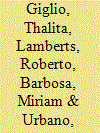|
|
|
Sort Order |
|
|
|
Items / Page
|
|
|
|
|
|
|
| Srl | Item |
| 1 |
ID:
126553


|
|
|
|
|
| Publication |
2013.
|
| Summary/Abstract |
This paper addresses the viability of converting single-family residential buildings in Brazil into zero energy buildings (ZEBs). The European Union and the United States aim ZEBs implementation to address 'peak oil' and environmental concerns. However, literature shows no agreement on a consensual definition of ZEB. Seeking a Brazilian ZEB definition, this paper addresses PassivHaus and thermal comfort standards for hot climates, source metrics for ZEB, Brazil's energy mix, residential energy end uses and Brazilian legal framework for residential photovoltaic (PV) generation. Internal Rate of Return for PV systems in two Brazilian cities is calculated under various scenarios. It shows grid parity was reached from April 2012 to November 2012 assuming residential electric tariffs of that period and the financial conditions given by the Brazilian government for the construction of new dams in the Amazon and the lowest rates offered by Brazilian banks to private individuals. Governmental decision to lower electric residential tariffs in November 2012 reduced the scope of grid parity. Later revocation of a tax exemption in April 2013 ended grid parity in Brazil. It concludes, conversely to developed countries, it is the volatile Brazilian energy policy, instead of economical barriers, the main obstacle for ZEB viability in Brazil.
|
|
|
|
|
|
|
|
|
|
|
|
|
|
|
|
| 2 |
ID:
132596


|
|
|
|
|
| Publication |
2014.
|
| Summary/Abstract |
Due to government subsidies, Brazil has witnessed an increase in the installation and use of small solar water heating systems in low-income housing projects. Although the initiative has reduced the load curve during peak times due to the reduced use of electric showerheads, measurement and verification (M&V) are needed to validate the savings. M&V procedures should take into account the social and economic variability of low-income housing developments. To improve M&V in low-income housing projects, this paper presents a methodology for identifying homogeneous subgroups based on their energy-saving potential. This research strategy involved a cluster analysis designed to improve the understanding of what energy savers and other influencing factors exist. A case study in Londrina Brazil was undertaken with 200 low-income families. Five clusters, created based on savings potential, were defined. The results showed that only two clusters demonstrated good electricity savings, representing 47% of families. However, two clusters, or 37%, did not provide satisfactory savings, and the other 16% did not provide any consumption history due to previous use of illegal city electricity connection practices. Therefore, studies confirm the need for a detailed measurement of the representative subgroups to assess the influence of human behaviour on potential SWHS-induced savings.
|
|
|
|
|
|
|
|
|
|
|
|
|
|
|
|
|
|
|
|
|